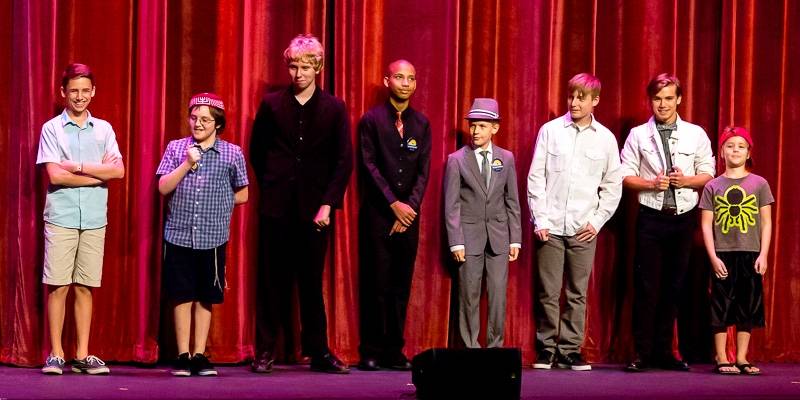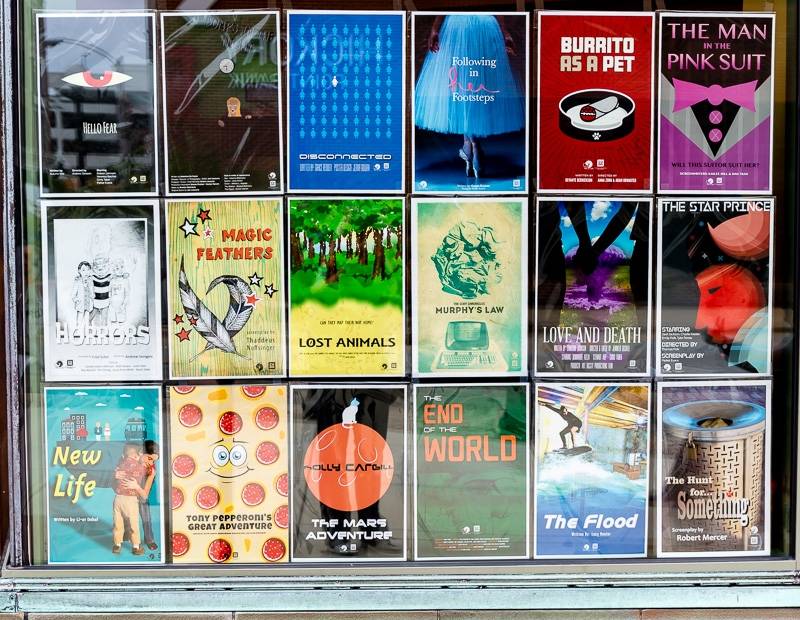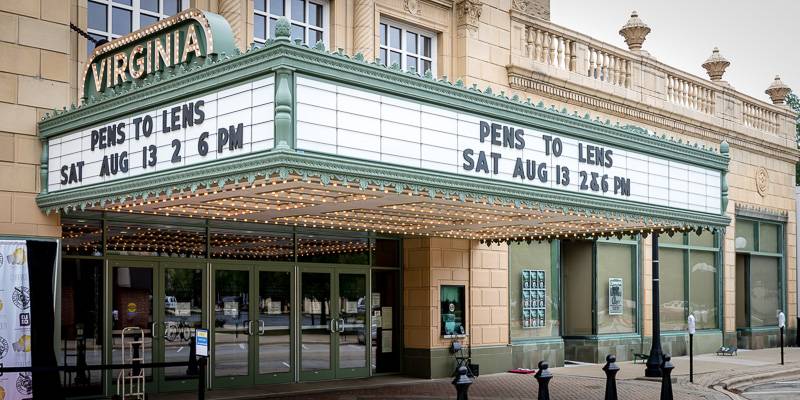 Every year, the Pens to Lens red carpet gala seems to get bigger and better, and as the preview reported, this year had several additional elements that were known ahead of time: an expanded Student Film Festival (all ages instead of just high school); downtime activities (P2L Bagz anyone?); and the panel discussion with two Hollywood directors. The most enjoyable addition for me, however, was a surprise – to me and everyone else – when host Cara Maurizi walked onstage and burst into an Oscar-style theme song she wrote especially for this year’s event, with orchestration by Brian Hagy. She revealed during a spoken interlude that she felt the event’s “senior year” deserved a special homage, and I think it set the tone perfectly for the rest of the day because it showed just how dedicated our creative community is to encouraging and supporting the next generation of artists. While Chris Taber did not sing during the second session, the actress and teacher encouraged participation by her students and appeared in several films herself.
Every year, the Pens to Lens red carpet gala seems to get bigger and better, and as the preview reported, this year had several additional elements that were known ahead of time: an expanded Student Film Festival (all ages instead of just high school); downtime activities (P2L Bagz anyone?); and the panel discussion with two Hollywood directors. The most enjoyable addition for me, however, was a surprise – to me and everyone else – when host Cara Maurizi walked onstage and burst into an Oscar-style theme song she wrote especially for this year’s event, with orchestration by Brian Hagy. She revealed during a spoken interlude that she felt the event’s “senior year” deserved a special homage, and I think it set the tone perfectly for the rest of the day because it showed just how dedicated our creative community is to encouraging and supporting the next generation of artists. While Chris Taber did not sing during the second session, the actress and teacher encouraged participation by her students and appeared in several films herself.


 That attitude of encouragement was observed by all the out-of-town presenters. Her face expressing amazement, Hollywood director Brenda Chapman shook her head and opened her panel discussion with the words, “Let me just say, growing up, we didn’t have anything like this.” She and her husband, director Kevin Lima, continued to marvel at the amazing opportunity that this program provides our youth throughout the entire discussion. Many of the audience questions centered around what young people should do to get ahead as animators, directors, and filmmakers, and the couple responded with advice about staying true to your own style and practicing constantly, both things that Pens to Lens validates by choosing original and interesting scripts. While answering a question by one of the Student Film Festival winners, Florence Lin (creator of the computer animated Flying Jedi), Chapman admitted that the fifth grader already knows more about animation than she did at that age, and to just keep learning. Another pertinent piece of advice given during the panel was, “Work with people you like and share stories.”
That attitude of encouragement was observed by all the out-of-town presenters. Her face expressing amazement, Hollywood director Brenda Chapman shook her head and opened her panel discussion with the words, “Let me just say, growing up, we didn’t have anything like this.” She and her husband, director Kevin Lima, continued to marvel at the amazing opportunity that this program provides our youth throughout the entire discussion. Many of the audience questions centered around what young people should do to get ahead as animators, directors, and filmmakers, and the couple responded with advice about staying true to your own style and practicing constantly, both things that Pens to Lens validates by choosing original and interesting scripts. While answering a question by one of the Student Film Festival winners, Florence Lin (creator of the computer animated Flying Jedi), Chapman admitted that the fifth grader already knows more about animation than she did at that age, and to just keep learning. Another pertinent piece of advice given during the panel was, “Work with people you like and share stories.”
That advice could not be any more embodied than it is by this particular program – which is evident as soon as you even glimpse at the credits of any given film – moreso if you watch them all back to back like we did on Saturday. Crossover was the rule rather than the exception, with directors being listed as actors, voice actors, puppeteers, grips, set construction, editors, sound engineers: it was basically all hands on all decks, and an extraordinary example of community cooperation. In the words of panelist moderator and guest from RogerEbert.com Matt Fagerholm, “It’s an obvious labor of love, and it’s such an honor to be here among young artists who are allowed and empowered to bring laughter and move people through film.”
 The professional film critic went on to say that when he heard about the idea at Ebertfest – thanks to Brett Hays of Shatterglass Studios – he immediately loved the idea. With a father who was a social worker who specialized in working with kids, he himself studied sociology and psychology, which is what drew him to movies as an art form. “It’s amazing to get inside the minds of these kids, and so revealing to see the same interests and anxieties finding the way onto the screen, but through younger eyes.” Continuing on in that vein, he told me that he was very impressed to be sitting next to a pair of Hollywood directors who were being moved to tears by a script written by a teenager (Listen by 8th grader Ethan Grinberg, directed by John Isberg, featuring tear-jerking music by Kurt Bielema and The Superior State). That exchange happened during the set break, before anyone saw the film Fast Rodney, Who Was On His Way Out.
The professional film critic went on to say that when he heard about the idea at Ebertfest – thanks to Brett Hays of Shatterglass Studios – he immediately loved the idea. With a father who was a social worker who specialized in working with kids, he himself studied sociology and psychology, which is what drew him to movies as an art form. “It’s amazing to get inside the minds of these kids, and so revealing to see the same interests and anxieties finding the way onto the screen, but through younger eyes.” Continuing on in that vein, he told me that he was very impressed to be sitting next to a pair of Hollywood directors who were being moved to tears by a script written by a teenager (Listen by 8th grader Ethan Grinberg, directed by John Isberg, featuring tear-jerking music by Kurt Bielema and The Superior State). That exchange happened during the set break, before anyone saw the film Fast Rodney, Who Was On His Way Out.
(You think you are ready, but stop, get some tissues, because this is some kind of one-two punch)
There were quite a few standout films, and several that dealt with serious subjects that adults don’t always think are appropriate for kids. The mature and moving film written by Gabriela DeLisle Diaz embodied both traits with help from local musician T.R.U.T.H., three directors of photography, and drone with a camera. The screenwriter said she was prompted to pen the story after the Baltimore shootings of 2015. She was dismayed that the top news stories nationally featured worldwide threats like ISIS and the Paris attacks, while domestic tragedies were overshadowed. While the original script featured more dialogue by the three main characters, director R.R. Berry made an editorial decision to shoot the film as nearly wordless, while still conveying plenty about the teens and their environments through their own actions and the actions of those around them. This tactic just made the message even more powerful, for most audience members.
Several of the places the stories were filmed are easy to recognize if you’re local, and I made the note, “61822 v. 61820 v. 61801”, which Gabriela said also heavily influenced her story. She moved here from Ann Arbor, Michigan, which is a similarly-sized Big 10 town, but is (in her words, and my experience) “almost this ideal place to grow up,” and continued on to express surprise at how C-U is so divided and has more than a few rough areas. While the film reads just as powerfully to people unfamiliar with our town’s geography, I think for us it has a specific meaning, thanks to the choices made by the photographers.
Even though this movie is emotionally difficult and deals with a tough topic for anyone, it’s encouraging to see that our community’s youth are both aware of and vocal about these ideas. It’s also a good thing to see that the youth are able to objectively observe our culture, like what’s presented in Wanda and Pickles Discover the Earth, by 8th grader Ella Kirwan. Two aliens take a look at common human rituals and find our society slightly disturbing. The comedic duo of Andrew Schiver and Lindsey Gates-Markel under the skilled direction of Anne Lukeman shed light on the oddity of actions we take for granted, and underscored the creative perspective penned by a teenager. Being able to question the standards through the lens of humor is a skill that can promote significant change, and it’s excellent to see in the minds of young people.
In fact, this box-exterior thinking was present in nearly all of the scripts that were turned into films, which is one of the things that makes this festival so different and enjoyable. Quick thinking and listening skills save the day in The Search for Pizza, empathy for deep attachment provides the horror in Burrito as a Pet and surrealism characterizes The Alarm Clock. Both the films that feature promising young actor Max Libman also stand out for the unique perspective they present. The End of the World, written by a quartet of eighth graders, hyperbolizes the impending doom of a playtime’s limit in a way that few adults could clearly remember. Student Film Festival winner Sarah Stelzer gives us a new look at “proper choices” during Summer Daze. And Potato Boy, oh, sweet Potato Boy, are you a ridiculous look at the seriousness of poverty, or are you a metaphor for how adults just cannot understand children? Either way, the look on Joi Hoffsommer’s face when she says, “All it needs now…is butter,” was probably my favorite moment of the night.
Potato Boy provided my best giggles, but the laugh-winner for the audience as a whole had to be Lance Lawson: the Case of the Misplaced Politician, a noir piece written by Mitchell Flanagin and directed by Charlie Kessler. Another example of how a great script needs an excellent director, Flanagin told me, “I didn’t explicitly write on the script that it was a parody, but they seemed to pick up on my dry sense of humor,” while Kessler said, “the sharp writing just drew me to this script.” I asked both the screenwriter and director who had the idea for the banana (my money was on the actor’s, actually) and they both copped that it was Charlie’s brainchild to make the detective orally-fixated. “I wanted him to be eating in every scene, instead of smoking,” he said, and the concept plays out perfectly, especially when a Dum-Dum stick emulates a cigarette.
Shatterglass Studios partnered with several of the short films this year, but Lance Lawson has some of the highest production values, with a local all-star cast as well. For example, voiceover artist Eric Sizemore appeared on screen to take no fewer than five dives during the fight scene on the fourth floor of the Lincoln building, while the patriarch of local theatre, Gary Ambler, did his best impression of a menacing mob-controlled mayor (evoking either Chris Cooper or Harvey Keitel, depending on who you ask). Grand dame Malia Andrus does her best broad, Bishop Stevens is appropriately imposing, and Thomas Polk really did fit himself into a garbage can. The result is a polished piece o’ work that truly drives home what is possible with just local resources.
The live-action black-and-white film also helps to highlight the diversity in style and execution that was on display during this fest. Even with so much cooperation going on, it’s still unlikely that the directors made decisions specifically different from each other. Even so, every choice was presented in a way that leaves no doubt these are professionally-made films. The computer animation in Bananas and Mr. Snake’s Big Adventure is so awesome that I actually felt the motion of the trip from treehouse to rocket (thanks, NCSA). Bumps in the Night and Hello, Fear brought the scary without being cheesy. According to the director, while filming The Star Prince at Allerton Park, a little girl climbed to the top of the gazebo to say hello to the princess (Venus, as played by Emily Polk). Professional puppeteers from Clothespin Puppets consulted on the intricate Horrors, and Lego animation is used to great effect in both the Student Film Festival grand prize winner The Weirder it Gets as well as The Runaway Toilet directed by Thomas Nicol. All in all, the acting, cinematography, costumes, and scripts made each and every film shine.

Attending a celebration like the Pens to Lens gala is a great way to celebrate our unique creative community. The earlier SP article said that the participation is the trophy, but it seems like the audience also qualify as prizewinners: we get a glimpse into the minds of our kids, and we get to laugh and be moved by the  films. It doesn’t hurt that our ticket prices support further ventures, our applause strengthens the confidence of our young artists and our volunteer hours count toward SAG-AFTRA’s contribution to “Million Hours of Mentorship” for A Call to Arts, either. If you weren’t able to attend, keep an eye out for the 2017 Gala’s announcement, and take a look at CU Film Society’s 2016 Pens to Lens playlist on youtube. If you like them as much as we do, consider purchasing a 2016 DVD from the Pens to Lens website, so the proceeds will continue to support future festivals. A showcase like this is worth keeping around, and has value to the community and to the future beyond even these kids’ imaginations.
films. It doesn’t hurt that our ticket prices support further ventures, our applause strengthens the confidence of our young artists and our volunteer hours count toward SAG-AFTRA’s contribution to “Million Hours of Mentorship” for A Call to Arts, either. If you weren’t able to attend, keep an eye out for the 2017 Gala’s announcement, and take a look at CU Film Society’s 2016 Pens to Lens playlist on youtube. If you like them as much as we do, consider purchasing a 2016 DVD from the Pens to Lens website, so the proceeds will continue to support future festivals. A showcase like this is worth keeping around, and has value to the community and to the future beyond even these kids’ imaginations.
All images by Scott Wells…
Scott is a U.S. Navy veteran and a graduate of the University of Illinois. He has been a photographer and writer for Smile Politely since March of 2015.









 Scott is a U.S. Navy veteran and a graduate of the University of Illinois. He has been a photographer and writer for Smile Politely since March of 2015.
Scott is a U.S. Navy veteran and a graduate of the University of Illinois. He has been a photographer and writer for Smile Politely since March of 2015.